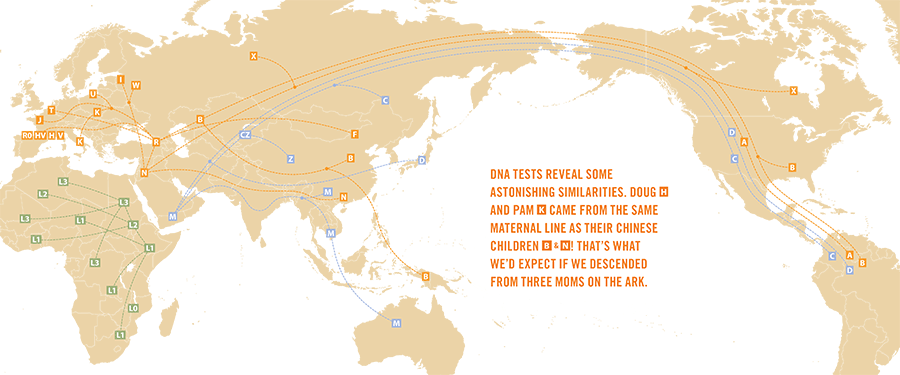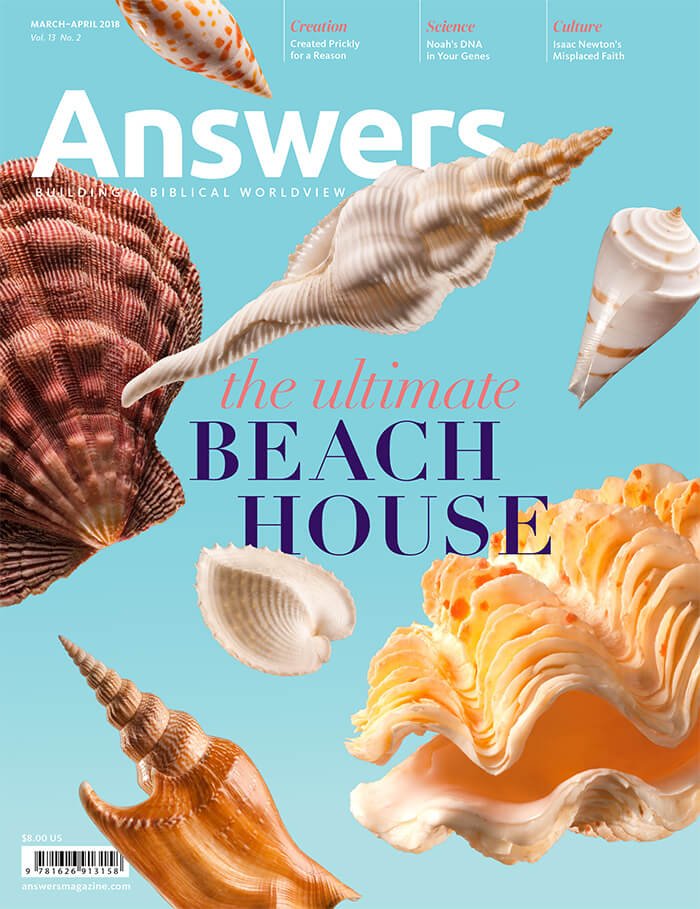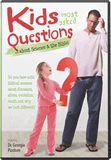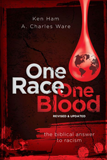Are We Really That Different?
The latest craze is to learn what DNA tests reveal about family heritage. When an adoptive Christian family decided to look beneath the surface, however, they discovered a more amazing truth.
At some point in your life, you’ve probably wondered about your heritage. Was your long-lost relative a servant in King Henry VIII’s palace, a pilgrim to the New World, or a soldier in the American Revolution? The possibilities are endless. Thanks to recent advances in DNA testing and extensive worldwide participation, you just might be able to find some answers.
Amid the piles of graphs and data you’ll receive from DNA testing companies, one little detail won’t be highlighted. But it’s even more amazing than finding a king (or outlaw!) in your closet. What if these tests show that your heritage—and everyone else’s—traces back to Noah’s family?
It’s not as far-fetched as it might sound. Noah was a real person, with three boys who married three women who became the mothers of all people on earth (Genesis 9:19). Did they pass down distinct DNA, which we can detect today?
Geneticists at Answers in Genesis (the parent ministry of Answers magazine) wanted to find out. They first looked for an average, run-of-the-mill midwestern US family who had adopted from China and would be willing to take a DNA test. On the surface, most of us would assume that North Americans of European heritage would have very different DNA from their Chinese-born children. But the answer is more complicated.
In fact, the test results provide powerful evidence that we are all one race, or “one blood,” just as the Bible teaches—ultimately descendants of one man and one woman (Genesis 1:27–28; Acts 17:26). The test also provides astonishing evidence that our ancestors go back only a few thousand years. But we will get to that later.
This is much more than a study of genetics. How two infants from China found a forever family in Northern Kentucky brings a wonderful truth to light. Whether adopted or natural-born, the Creator gave us the similarities we need to make unity possible, while he gave us enough differences to make every family wonderful.
Becoming a Family
“God’s plans are always greater than ours.”
If you spend any time with Doug and Pam Duty, you’ll hear this phrase often. They had no plans to adopt. God had already blessed them with three lovely biological daughters, ages 17, 15, and 10. At this stage in life, most parents are thinking about college, weddings, and grandkids.
“I had my own dreams of retirement and what that would look like,” Doug remembers. “But when the Lord spoke to us, we decided to adopt right away, and we surrendered immediately. . . . Of course, I’m joking.”
Doug really did have his life’s plan laid out, including retirement as a pharmaceutical salesman. Then one fateful day, as he flew out on another business trip, his wife was folding laundry in their bedroom and listening to a family on the radio sharing their adoption story. She had heard similar stories before, but for some reason this one stuck. She doesn’t even recall the details. “Doug was gone for an entire week, while I was home every day thinking about that story.”
When Doug came home, Pam said they needed to talk. “That’s usually a scary thing,” Doug jokes. Out of the blue, Pam told him she felt God calling them to adopt. They’d never discussed such a thing before.
Doug feared Pam might be having a midlife crisis, so they put the conversation on the back burner. Yet from May until October, God was “relentless,” Doug admits.
For him, one of the greatest obstacles was the expense. Then one day, as he was at home reviewing his company’s new benefits, Pam heard Doug yell, “You’ve got to be kidding! Our new policy will pay $10,000 toward all international adoptions.”
Another sign came a few weeks later, when a foster family asked randomly if they had ever considered adoption. Pam kept a journal of such indicators and would occasionally share them with Doug.
The turning point came when their daughter’s friend wanted to have an abortion. Doug’s immediate thought was that his family needed to adopt the baby and save it. Sadly, the teen still decided to end the pregnancy; but Doug’s heart had changed about the power of adoption to save a life.
Now it was Pam’s turn to need convincing. Then one day while she was in the garage organizing, the name Sophie came to her mind and she couldn’t stop thinking about it. Then, for three nights in a row she dreamed about a little girl named Sophie.
“I never saw her face, but I knew she was Asian. I thought, if we ever adopt, I will call the child Sophie. Before I even met her, God had already given me her name.”
One Friday morning at church, during a Bible study about the crossing of the Red Sea, she broke. The speaker asked, “Ladies, what is something God has been calling you to do, and you’ve been making up every excuse not to do?”
The next two-and-a-half years were a whirlwind—finding an adoption agency, picking a country, working out details. Finally, their plane landed in Beijing, China, and they laid eyes on a 13-month-old baby who would soon be called Sophie.
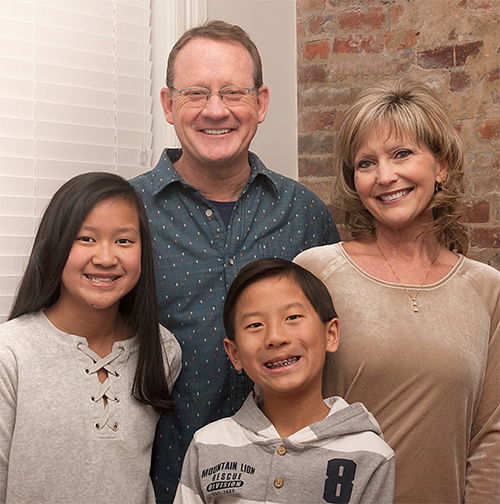
At first, Sophie was unresponsive because she had received so little interaction with adults at the orphanage. Like a three-month-old, she couldn’t sit up, crawl, or communicate. But after just 16 days with her new parents and while still in China, she was already on her way to a rich new life—sitting up, holding her mom’s and dad’s hands, and even walking.
Five years later, the desire to adopt tugged at Doug and Pam once again. The cutoff age to adopt from China was 50, a milestone they were quickly approaching. Did God want them to bring new hope to one more child? They contacted an adoption agency for more information, and the next thing they knew they were back in China, but this time for a boy. The only way to complete an adoption so quickly was to choose a special-needs child.
Adopting a healthy baby already had its own problems. Sophie had quickly grown attached to her adoptive parents and suffered extreme anxiety whenever they weren’t within reach. Their new son, Collin, had additional challenges in his adjustment. First, he was already three years old and speaking fluent Mandarin, so he would have to learn a new language. Second, he had a severe cleft palate that needed more surgeries.
But Collin had more than medical obstacles to overcome. After every meal, he would hide food in his pockets. He even went as far as taking food off strangers’ plates at restaurants. “In these orphanages, many kids don’t know when they’ll receive their next meal,” Pam explains.
Today, Collin is 10 and has had several successful surgeries. Sophie is 12 and already dreams about college.
“There are times we look back as we’re doing homework with young children and think, ‘This is not what we planned.’ But it is not about us,” Pam says. And the rewards have been immeasurable.
“There’s no difference in our family. Whether adopted or not, you’re our child and that makes you a Duty.”
The Dutys believe the first day they saw pictures of Sophie and Collin, long before they even met them face to face, they were their kids. “There’s no difference in our family. Whether adopted or not, you’re our child and that makes you a Duty.”
God has everything to do with bringing together families like this. Despite the cultural differences, the Dutys realized a biblical truth: we are all one family, descended from Adam. And God intends for us to love one another as family, no matter what minor differences seem to divide us.
DNA Evidence for One Race
When Answers magazine approached the Dutys about a DNA test, they were intrigued. They didn’t realize just how much it would prove that “we’re all one family.”
The main test results, which most people are looking for, weren’t shocking. Doug and Pam are of European descent, and Sophie and Collin are East Asian. Pam leans strongly toward British Isle genes, while Doug’s genes are a mix of the British Isles and West/Central Europe. Their children are a mix of southeast and northeast Asian.
The genetic differences that indicate these ethnicities are extremely minor. Most were inherited from Adam and Eve. As their descendants moved out from Babel, their genes acquired minor additional variations due to mutations (alterations to a DNA sequence), and it is possible to track which regions of the world still carry these minor variations. Across the globe, 99.9% of DNA is the same. This similarity is beautifully consistent with the biblical account of human history, from the creation of the first couple in Eden to the spread of Noah’s family from the ark just a few thousand years ago.
When most people talk about DNA, they mean the long string of genetic material found in each cell’s nucleus, known as nuclear DNA. This is the DNA that defines our eye color, hair, and other physical characteristics. Most tests just examine this nuclear DNA, and it showed the Dutys’ ethnic differences.
But the geneticists at Answers in Genesis were interested in a separate test, which you can run on a less-well-known string known as mitochondrial DNA. This small set of genes is located inside a part of our cells called mitochondria, the cell’s “energy factories.” These energy factories are located outside the nucleus and have their own separate DNA.
The advantage of this string is that the DNA doesn’t go through as many changes, and geneticists have fewer factors to consider when comparing them. Unlike nuclear DNA, which is passed down by combining DNA from both parents, mitochondrial DNA is passed down directly from the mother. So you don’t have to factor any mixing from different male lineages over the centuries.
Furthermore, mitochondrial DNA has only 16,569 base pairs (DNA’s building blocks) as opposed to over 6 billion base pairs in our nucleus. So mutations are much easier to track. (In fact, the highest number of mutations recorded in the human race is just over 120.)
Such a limited number of mutations means that little time has passed for mutations to occur since the first mother passed down her DNA! With such a simple, clean record, it is much easier to reconstruct each individual’s maternal family tree.
The difference between the two parents and their two Chinese children is no greater than the difference between Doug and Pam!
When the geneticists asked the Dutys to do a mitochondrial DNA test, even the scientists were shocked by what they found. The difference between the two parents and their two Chinese children is no greater than the difference between Doug and Pam!
These results make sense if today’s billions of people are the descendants of only eight people on Noah’s ark. If different ethnic groups in China and Europe came from one mother roughly 4,350 years ago, then too little time has passed for many differences to appear in their mitochondrial DNA. If these groups had been separated by 100,000 years or more, as evolutionists claim, we would expect to find more DNA differences. But we don’t.
So, in answer to the question at the beginning of this article, yes, we can all trace our heritage back to the wives of Noah’s sons, who were on the ark.
Even though Collin and Sophie are not the biological children of Doug and Pam, they still share DNA from the same family, which goes all the way back to the flood.
Collin often asks Doug why his eyes are shaped differently. Doug always tells him, “It’s because you’re Asian . . . but you’re still my son.” Even though variations like eye shape and skin color are easy to spot, they are very minor. These superficial differences, which so many people consider major, compose a very small percentage of DNA.
Today, millions of people are eagerly taking DNA tests to learn more about their heritage. The tests sometimes show that their family roots are separated by thousands of miles. Upon closer inspection, however, the story is immensely different.
The Bible’s claim that we’re “one blood” (Acts 17:26 KJV) means we’re all from one family. Every person on this earth is a descendant of the first Adam (1 Corinthians 15:45), who was created in the image of God. Even though the first Adam sinned in the garden of Eden, God sent Jesus Christ as the second Adam. Because of his death on the cross, we can be saved from our sin and adopted into God’s family.
Both Sophie and Collin were abandoned by their birth parents and left in public places. But God, who loves helpless orphans, used their tragic circumstances to transform their lives into a story of his grace. Such stories remind us that we are, indeed, one family, and God’s love can overcome seemingly impossible barriers to unite us.
What DNA Tests Can Show About Your Ancestry
When they send saliva to be tested, most people want to know one result: the areas their ancestors came from. This is based on mutations in our DNA (called nuclear DNA).
But you have another small set of genes (called mitochondrial DNA), which yields better information. This string is located inside your cells’ mitochondria, or “energy factories.” It is passed down directly from the mother, so its mutations are easier to track. From this, we can identify your maternal family tree (see map below).
Testing companies won’t tell you one thing shown on the map below. These maternal lines can be traced back to three branches, most likely the wives of Noah’s three sons!
Two Different Results
You can get test results for either nuclear DNA or mitochondrial DNA. Nuclear DNA shows that Doug and Pam came from Europe; Sophie and Collin from Asia. Mitochondrial DNA shows they came from four separate maternal lines (H, K, B, N).
| Nuclear | Mitochondrial | |
|---|---|---|
| Doug | European | H-Type |
| Pam | European | K-Type |
| Sophie | Asia-Pacific | B-Type |
| Collin | Asia-Pacific | N-Type |
Many Letters, Three Moms
The map shows letters for all the mitochondrial DNA types and where they spread. In orange are the results for Doug (H) and Pam (K) and their adopted children, Sophie (B) and Collin (N). When you look closer at these four lines of maternal DNA, they are so similar that they actually belong to the same family tree (“Mom 1” below)!
If you know your mitochondrial DNA type, you can find which mom you come from in the chart below.
| Mom 1 | Mom 2 | Mom 3 |
|---|---|---|
| N | M | L3 |
| R | CZ | L2 |
| B | Z | L1 |
| W | C | L0 |
| A | D | L5 |
| U | G | L6 |
| T | Q | L4 |
| J | ||
| R0 | ||
| X | ||
| K | ||
| F | ||
| H | ||
| HV | ||
| V | ||
| I |
Related Videos
Why Do We Look Different?
Answers Magazine
March–April 2018
The beach beckons us with its seashells. More than just ornate collectables, they testify to the Creator’s lavish provision for even the lowliest creatures. The Creator designed shells with mind-boggling features evolution can’t begin to explain.
Browse Issue SubscribeRecommended Resources

Answers in Genesis is an apologetics ministry, dedicated to helping Christians defend their faith and proclaim the good news of Jesus Christ.
- Customer Service 800.778.3390
- © 2024 Answers in Genesis



